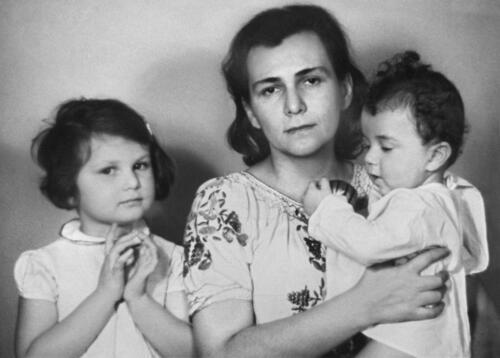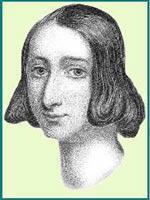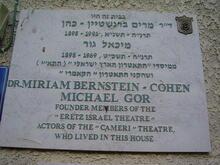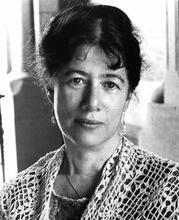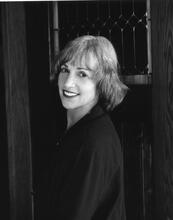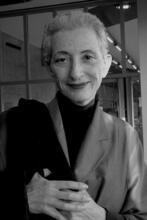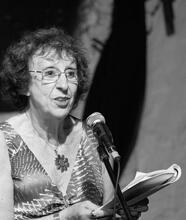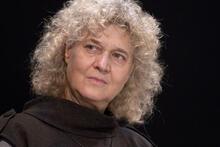Ewa Kuryluk
Ewa Kuryluk is an author, writer, essayist, artist, and art historian. Born in Poland, she did not know for a long time that her mother was a Jew and a member of the underground whose survival had been facilitated by her future husband. In addition to publishing in the field of art history, she has produced art held by museums around the world; in her work, she merges different media and aesthetic vernacular and transgresses the established borders between essay and narrative and even between drawing and writing. Her postmodern arrangements are interspersed with references to historical events that allude to Jewish history. She has also written poetry and novels, including an autobiographically informed novel that traces the vectors of a Polish Jewish family from persecution to postwar antisemitism.
Upbringing and Beginnings as an Artist and Writer
An author, writer, essayist, artist, and art historian, Ewa Kuryluk was born in Cracow, Poland, on May 5, 1946. Her father Karol, born in 1910 in Zbaraz, Poland (now Ukraine), studied at the University of Lwów. Her mother, Miriam (née Kohany), was born in Bielsko-Biala (Poland) in 1917); a translator, writer, and pianist, she was first married to Teddy Gleich (1912–1946). For a long time, Ewa did not know that her mother was a Jew and member of the underground whose survival (in Lwów) had been facilitated by her future husband Karol.
Around 1944 the couple moved from Lwów to Lublin and later to Cracow and Warsaw. Karol Kuryluk became the founder and editor-in-chief (1933–1939) of the magazine Sygnaly and served as minister of culture from 1956 to 1958. In 1959 he became ambassador to Austria, remaining in Vienna until 1964. He died in 1967, Ewa’s mother in 2001.
From 1964 to 1970 Ewa Kuryluk studied at the Academy of Fine Arts in Cracow, where she received an MFA in painting and an MS in art history. From 1970 to 1973 she studied art history at the Jagiellonian University in Cracow, receiving her PhD with a thesis on the origins, iconography, and techniques of the grotesque, which was published in Poland and in the United States in 1987.
A Prolific Career
Ewa’s first publications (essays and poems) appeared in 1973, followed by works on fin de siècle Vienna (1974, based on her master’s thesis) and a book on Audrey Beardsley in 1976. In 1981 she settled in the United States, where she later received several fellowships from the New York Institute for the Humanities, at New York University (1982–1985), Princeton University (1984–1985), and the National Humanities Center in North Carolina (1988–1989). In 1981 she became one of the founding editors of the journal Zeszyty Literackie. From 1988 to 1992 she taught on the Graduate Faculty of the New School for Social Research in New York and in 1992 she was a visiting professor at the University of California in San Diego.
Kuryluk continued to publish in the field of art history, most notably with her books Salomé and Judas in the Cave of Sex: The Grotesque: Origins, Iconography, Techniques (1987, based on her dissertation) and Veronica and Her Cloth: History, Symbolism, and Structure of a “True” Image (English edition 1991, Polish edition 1998). She currently lives in Paris and Poland.
Kuryluk’s artistic production has been recognized with installations exhibited in Europe and in the United States. More than twenty museums all over the world own works of art created by her, among them the National Museums in Warsaw, Cracow, Poznan, and Wroclaw and the Museum of Modern Art in Lodz. With more than 40 solo exhibitions and more than 60 group shows, Kuryluk has established herself as one of Poland’s most prolific female artists of her generation. Among the many books and catalogs of her work are Fabric of Memory: Ewa Kuryluk Cloth Works 1978–1987 and Don't dream about love, Kuryluk, Paitings 1967-1978, and Kangaroo with the Camera: 1959-2009.
Kuryluk’s two volumes of poetry, Contour (1979) and Miss Anima (1984), were published in Poland, while two of her four novels, Century 21 and Grand Hotel Oriental, appeared originally in English in the United States in 1992 and 1997 respectively. Century 21 is a monumental novel, rich in references to a vast array of cultural icons of the European tradition (ranging from Sextus Propertius and Moses Maimonides to Malcolm Lowry and Simone Weil). They are assembled in a narrative texture that mixes genres and styles freely and playfully
Goldi, published in 2004, is an autobiographically informed novel that traces the vectors of a Polish Jewish family from persecution to postwar anti-Semitism, the vicissitudes of the Polish intelligentsia through the events leading up to 1968. Intellectual and political history provides a palimpsest for the story of a family that Kuryluk portrays through the lens of the family hamster Goldi. The animal fable omits the term “Jew” in reference to both her mother’s silence about her identity and Poland’s difficulty in addressing its anti-Semitic history.
In her artistic work Kuryluk merges different media and aesthetic vernacular and transgresses the established borders between essay and narrative and even between drawing and writing, creating installations in which the written word appears as yet another form of the drawing, not competing with the abstract line but complementing it. In her novels, most notably in Century 2001, borders between different cultural realms and eras become blurred to give way to postmodern tableaux in which historical figures from vastly different backgrounds suddenly communicate with each other. These postmodern arrangements are interspersed with references to historical events that allude to Jewish history also, though without displaying any overriding concern with the Jewish people. A global artist with modernist sensibilities, Kuryluk mediates between cultures, traditions and periods to create a view of history that goes beyond a mere review of positions surpassed and left behind to suggest a never-ending stream of consciousness in which every cultural utterance is eventually met with a response.
Selected Works
Kontur: Wiersze z lat 1972–1975 (Collected Poems). Cracow: Wydawnictwo Literackie, 1979
Pani Anima: Wiersze z lat 1975–1979 (Collected Poems). Cracow: Wydawnictwo Literackie, 1984
Century 21. Normal IL: Dalkey Archive Press, 1992 (later translated into Polish).
Grand Hotel Oriental. Oxford: Basil Backwell, 1991 (later translated into Polish).
Encyklopedierotyk. Warsaw: Sic!, 2001
Goldi. Warsaw: Twoj Styl, 2004.
Frascati. Cracow: Wydawnictwo Literackie, 2009
Art History (Selection)
Salome and Judas in the Cave of Sex. The Grotesque: Origins, Iconography, Techniques, Evanston, IL: Northwestern University Press, 1987.
Veronica & Her Cloth: History, Symbolism and Structure of a “True” Image. Oxford: Basil Blackwell, 1991.
Criticism (Selection)
Mieczyslaw Porebski, Tableaux de Ewa Kuryluk. Paris: Galerie Lambert, 1974.

